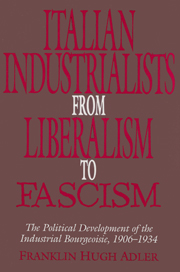 Italian Industrialists from Liberalism to Fascism
Italian Industrialists from Liberalism to Fascism Book contents
- Frontmatter
- Contents
- Preface
- List of abbreviations
- Italian Industrialists from Liberalism to Fascism
- Introduction
- 1 Associational development during the Giolitti era
- 2 The First World War: a precorporatist experience
- 3 The postwar crisis and the rise of Fascism
- 4 Liberal–Fascism
- 5 Industrialists and nonintegral corporatism
- Conclusion
- Index
5 - Industrialists and nonintegral corporatism
Published online by Cambridge University Press: 06 November 2009
- Frontmatter
- Contents
- Preface
- List of abbreviations
- Italian Industrialists from Liberalism to Fascism
- Introduction
- 1 Associational development during the Giolitti era
- 2 The First World War: a precorporatist experience
- 3 The postwar crisis and the rise of Fascism
- 4 Liberal–Fascism
- 5 Industrialists and nonintegral corporatism
- Conclusion
- Index
Summary
During the period of liberal–Fascism, Confindustria had never been forced to define itself as Fascist. It had retained an autonomous liberal identity, giving conditional and contingent support – as did liberals in general – to Mussolini as prime minister of duly constituted government, not to Mussolini as Duce, much less to Fascism per se. By the beginning of 1925, in the aftermath of the Matteotti crisis, the four-year liberal–Fascist convergence had broken down. No longer was there manifest concern shown by Mussolini for continuity with the traditional liberal state, nor was there further talk of normalization. By the end of 1925, foundations for a new, distinctively antiliberal state had already been laid, the final edifice to be fully erected in subsequent years.
Forced at the end of 1924 to choose between liberal fiancheggiatori and intransigent Fascists, whose respective demands could no longer be reconciled within the faltering framework of liberal–Fascism, Mussolini tentatively sided with the intransigents. Within two years, however, they too would be neutralized, as the party was reduced to little more than a disciplined and pitifully dependent extension of the state. Quite apart from the need to substitute a new juridical order for the negated liberal state, more pressing problems (civil unrest, continuing Fascist violence, and four separate attempts on Mussolini's life) led to a whole series of party directives and repressive laws: the squads were demobilized, the party was “purified ”of recalcitrant elements, and local leadership was made subservient to the prefect.
- Type
- Chapter
- Information
- Italian Industrialists from Liberalism to FascismThe Political Development of the Industrial Bourgeoisie, 1906–34, pp. 344 - 436Publisher: Cambridge University PressPrint publication year: 1995


